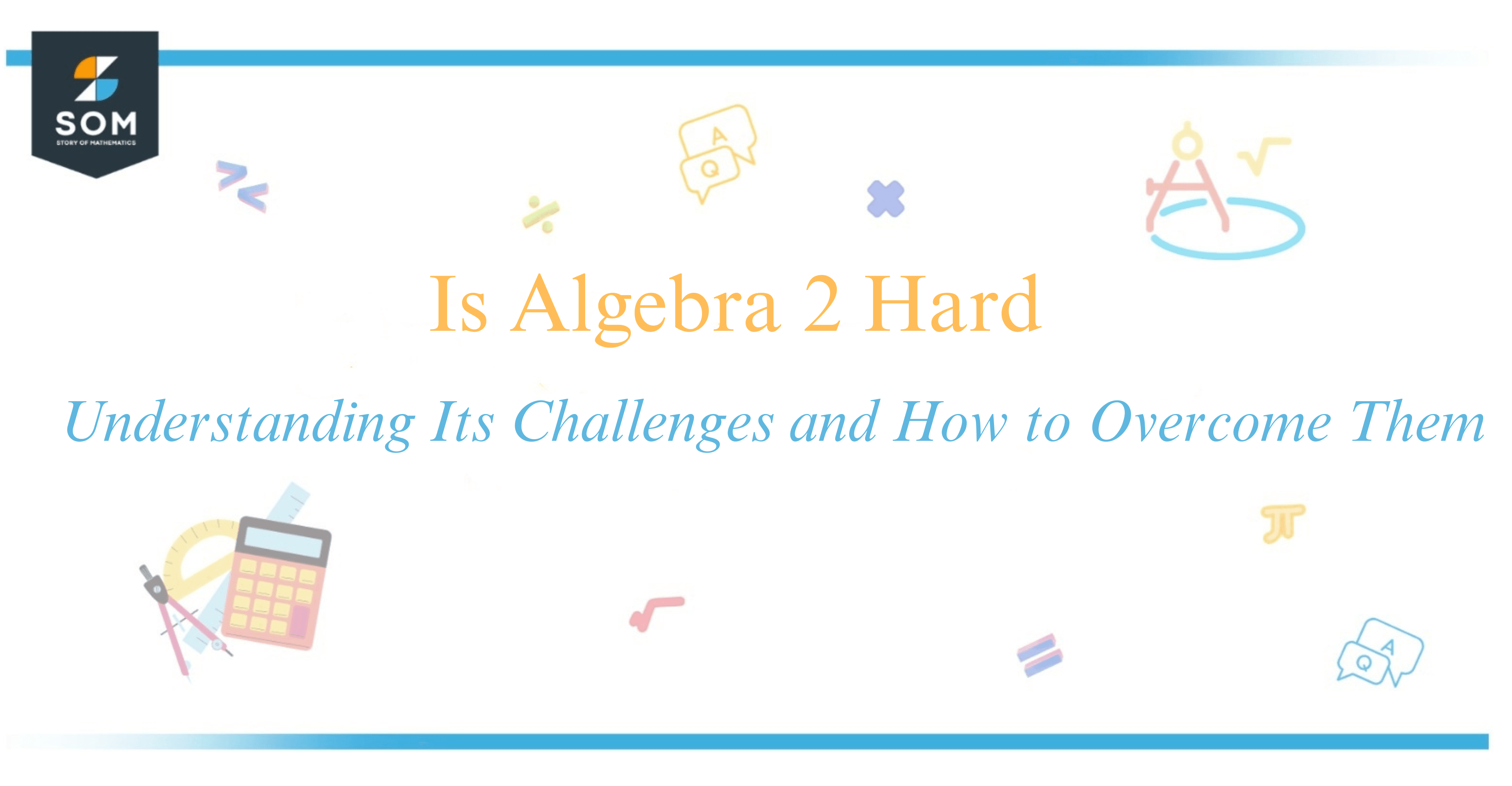JUMP TO TOPIC

Yes, Algebra 2 can be challenging. It is a significant step up from Algebra 1, introducing students to a range of new and more complex concepts. As part of the high school curriculum, Algebra 2 often requires a solid understanding of previous math courses, as it builds upon that foundation with advanced functions, polynomials, and an introduction to trigonometric functions.
I’ve noticed that tackling exponential and logarithmic equations, for example, can trip up even the most diligent students. The leap into abstract reasoning, along with the introduction of imaginary numbers and complex polynomials, adds layers of difficulty to an already rigorous mathematical path.
But, while it’s a tough nut to crack, mastering Algebra 2 is a pivotal moment in laying the groundwork for future success in higher-level math and science courses. So, as you dive into the complexities of Algebra 2, keep in mind that the challenge is a necessary step toward a rewarding comprehension of mathematics.
Understanding Algebra 2 Fundamentals
When I first approached Algebra 2, I realized it was a step up from Algebra 1, involving more complex concepts that require a strong foundation. Here’s an outline of essential components.
Variables & Operations
In Algebra 1, I became comfortable with basic variables and operations. However, Algebra 2 expands on these:
- Variables become more intricate, often involving multiple variables in single equations.
- Standard operations (+, -, *, /) are joined by more nuanced manipulations like factoring and rationalizing complex expressions.
Functions & Their Types
Functions form a cornerstone of Algebra 2. I learned to go beyond linear functions ($y = mx + b$), exploring various types:
- Quadratic ($y = ax^2 + bx + c$)
- Polynomial
- Exponential ($y = a^x$)
- Logarithmic ($y = \log_b(x)$)
- Trigonometric (sine, cosine, tangent)
Equations & Solutions
Algebra 2 pushed me to solve equations that could look intimidating at first. For each type of function, there are corresponding methods to find solutions:
| Function Type | Solution Method |
|---|---|
| Quadratic | Factoring, Quadratic Formula |
| Polynomial | Synthetic Division, Factoring |
| Exponential | Logarithmic Operations |
| Logarithmic | Exponentiating |
| Trigonometric | Inverse Trigonometric Functions |
By synthesizing concepts from Algebra 1 with new operations and functions, I developed a robust comprehension of Algebra 2 fundamentals. Mastery became a matter of practice and applying these principles to increasingly complex problems.
Complex Concepts in Algebra 2
In my journey through Algebra 2, I’ve encountered several complex concepts that often challenge students. These are not just numerical operations but whole new ideas that expand upon what I learned in Algebra 1.

First, let’s talk about the complex numbers. They consist of a real and an imaginary part, and I’ve learned that they’re vital for solving equations that have no real solutions. For example, the square root of -1, a number impossible on the real number line, is denoted as i in complex numbers, and a typical complex number looks like ( a + bi ).
Polynomials are expressions that include variables raised to different powers, often requiring various methods to solve or simplify. Their degrees can indicate complexity; I’ve seen that a quadratic, which is a second-degree polynomial, will graph as a curve and follow the form ( ax^2 + bx + c ).
The Quadratic equations are special types of polynomials, and mastering them is central to succeeding in Algebra 2. I’ve solved these by means like factoring, using the quadratic formula ( x = $\frac{{-b \pm \sqrt{{b^2 – 4ac}}}}{{2a}}$ ), or completing the square.
Table 1: Methods of Solving Quadratic Equations
| Method | Description |
|---|---|
| Factoring | Decomposing into products of simpler expressions |
| Quadratic Formula | Applying a universal formula |
| Completing the Square | Rearranging into a perfect square plus a constant |
Lastly, factorization is breaking down more complex expressions into products of simpler ones. I see factorization as a puzzle – I look for things like the greatest common factors or special products to simplify expressions.
These concepts are foundational in Algebra 2, and understanding them has enabled me to tackle advanced math problems with greater confidence.
Algebra 2: Bridging Arithmetic and Calculus
In Algebra 2, I often see students transitioning from basic arithmetic to a more complex understanding of mathematics that leads to calculus.
This course serves as an important foundation fpr mathematical reasoning and introduces key concepts such as sequences, series, inequalities, radicals, and even some fundamental ideas of calculus.
When exploring sequences and series, my focus is on understanding patterns and their summations. For example, an arithmetic series may look like this:
$$ S_n = \frac{n}{2}(a_1 + a_n) $$
Here, ( S_n ) represents the sum of ( n ) terms, ( a_1 ) is the first term, and ( a_n ) is the last term.
Moving to inequalities, it’s essential to visually represent solutions and comprehend how different values relate to each other. Consider a simple inequality:
$$ 2x + 3 > 5 $$
I would solve for ( x ) and then graph the solution on a number line.
Radicals, on the other hand, require my attention to detail as I simplify expressions and solve equations. The process involves understanding the properties of square roots and other roots, which are vital in calculus as well.
Lastly, I’ve noticed introductory topics from calculus, such as limits and instantaneous rates of change, sometimes make an appearance. Whereas calculus delves deeper into these topics, Algebra 2 introduces them to bridge the student’s understanding to higher-level concepts.
Here’s a simple representation of what the introduction to calculus in Algebra 2 looks like:
| Concept in Algebra 2 | Relevance to Calculus |
|---|---|
| Sequences | Leads to series |
| Series | Foundation for integrals |
| Inequalities | Understand function behavior |
| Radicals | Precedes work with limits |
| Basic limits | Precursor to derivatives |
This interplay deepens my understanding of Algebra 2 as not just an isolated subject but a vital step towards mastering calculus.
Challenges and Support in Algebra 2
In my study of Algebra 2, I found that it naturally presents a variety of challenges that build upon the foundation of Algebra 1. One significant hurdle is the introduction of new concepts such as:
- Logarithms, e.g., solving for $x$ in the equation $log(x) = 2$
- Trigonometry, involving relationships between side lengths and angles of triangles
- Conic sections, which include ellipses, parabolas, and hyperbolas
The difficulty of these topics can sometimes feel overwhelming, especially if my grasp on Algebra 1 topics isn’t strong. For me, practice is crucial. Daily homework enhances my understanding of complex ideas and helps me become proficient with various types of algebraic equations.
Support systems are vital in navigating the complexities of Algebra 2. A good teacher can make a significant difference by providing clear explanations and individual assistance. A personal tutor can also offer additional help, breaking down the steps of problematic equations one-on-one.
When extra guidance is needed, I turn to resources like Khan Academy. It’s a valuable tool, offering video tutorials and practice exercises that cater to a range of learning styles.
Support Strategies I Use:
- Dedicated Practice: Regularly working through problem sets to reinforce new concepts.
- Seeking Help: Asking my teacher or tutor to clarify difficult topics.
- Online Resources: Utilizing platforms like Khan Academy for supplemental learning.
By committing to consistent practice and utilizing available support resources, I find that mastering Algebra 2 becomes a more attainable goal.
Applications of Algebra 2
Algebra 2 is a crucial stepping stone in my mathematical education, particularly as I consider pursuing further studies in various fields. It lays the groundwork for advanced mathematical concepts I encounter in higher education, especially if I’m aiming for a science or engineering bachelor’s degree.
For instance, in Algebra 2, I learned about complex numbers, which are essential in solving polynomial equations that appear in electrical engineering. The equation $i^2 = -1$ is the foundation for complex numbers, where i is the imaginary unit. Without this knowledge, understanding alternating current (AC) circuits in college would be much more challenging.
Additionally, Algebra 2 equips me with skills to handle logarithmic equations. These are vital in fields like biology and earth sciences, where I need to analyze growth patterns and pH levels, represented by the equation $y = \log_b (x)$.
In physics or any science-related bachelor’s degree, mastery of Algebra 2 helps me grasp concepts like exponential growth and decay. This concept can be modeled by the equation $A = A_0e^{kt}$, where A is the amount of substance, $A_0$ is the initial amount, k is the rate constant, and t is time.
Moreover, for a student pursuing a degree with roots in analytics, such as economics or even some social sciences, Algebra 2 teaches the understanding of functions and models, essential for interpreting data.
Here’s a brief look at potential applications by degree type:
| Degree Type | Application of Algebra 2 |
|---|---|
| Associate’s Degree | Algebraic equations in technical fields and trades |
| Bachelor’s Science | Trigonometry, calculus preparation, scientific modeling |
| Bachelor’s Engineering | Complex numbers in circuit analysis and dynamic systems |
My analytical skills are honed through problem-solving methods learned in Algebra 2, making me a competent candidate for complex and quantitative college courses.
Conclusion
In my journey through mathematics, I’ve found that Algebra 2 presents a significant step up from Algebra 1. This isn’t just my experience; many students and educators share this sentiment.
The introduction of more complex topics such as exponential functions, and logarithms, and the deeper exploration of quadratic equations indicates that there is a higher level of conceptual understanding required for success.
The complexity increases with the inclusion of trigonometry. For instance, understanding the unit circle and the relationships between sine, cosine, and tangent involves not only algebraic skills but also the geometric visualization. Concepts like:
- The Exponential equations, where I’d solve for $x$ in equations like $5^x = 125$.
- The Logarithmic equations, which include solving for $x$ in equations like $\log(x) = 3$.
These are just a sampling of the type of work that adds layers of difficulty compared to Algebra 1.
My advice to anyone tackling Algebra 2 is to build a strong foundation in Algebra 1 concepts. I make sure to review past materials, practice consistently, and don’t be afraid to ask for help when new or challenging topics arise. Moreover, adopting a problem-solving mindset and not being deterred by initial difficulties will prove invaluable.
Navigating through Algebra 2 successfully can be a rewarding experience that opens up a world of mathematical understanding, preparing students for advanced topics in mathematics and related fields.
